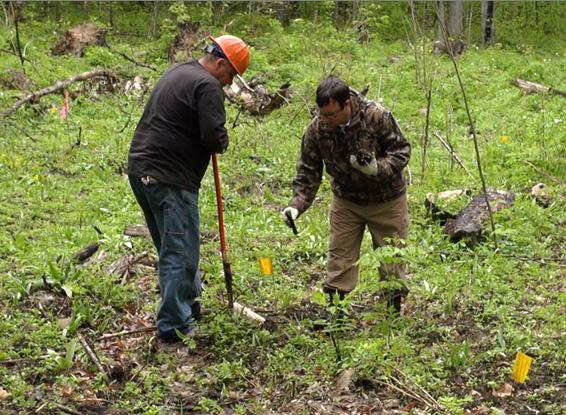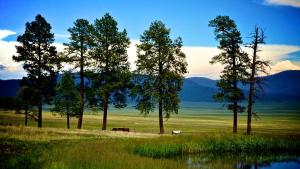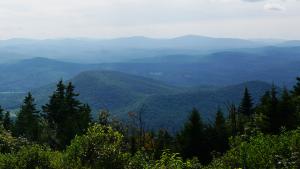"Start with the rising sun and work toward the setting sun, but take only the mature trees, the sick trees, and the trees that have fallen. When you reach the end of the reservation, turn and cut from the setting sun to the rising sun and the trees will last forever."
—Attributed to Chief Oshkosh, Menominee Nation
A rich history of sustainability
For more than 150 years, the Menominee Tribe of northern Wisconsin has pioneered practices that preserve more than 200,000 acres of diverse forested land. The tribe’s long history of sustainable land management has enabled the Menominee to maintain a healthy forest, even as they have harvested half a billion feet of lumber from the lands since the mid-1800s.
“Throughout history, Menominees have been a woodland people,” says Tony Waupochick, a Menominee silviculturist and forester. “As the early Menominee leaders started to make their decisions about harvesting the timber on the reservation, they always maintained the concept that they never wanted to harvest more than what the forest can provide. Basically, that was an early concept of sustainability.”
Menominee lands feature expansive forests of maple, oak, and birch trees, prized for their beauty, diversity, and valuable wood. Despite their productivity, the forest is vulnerable to pests, disease, and invasive species. These threats are likely to worsen when combined with the effects of a changing climate. For example, warmer temperatures may promote the viability of insects that interfere with tree growth, and increased frequency and intensity of drought can make trees more susceptible to insects and diseases. This increases their risk of being out-competed by invasive plants.
As Menominee Tribal Enterprises (MTE) became aware of these risks, they chose to take action to build the forest’s resilience.
Oak wilt disease
Oak wilt, an invasive fungus in northern Wisconsin, spreads through tree roots or by sap-feeding beetles. The disease can kill red oak trees by plugging up the cells that move water from their roots to their leaves.
“Trees typically wilt and lose their leaves very fast,” says David Mausel, a forest entomologist/pathologist with MTE. “They’ll turn brown or mottled green. All the leaves fall down very fast, like in a week or two, and cover the ground in a halo right beneath the trees.”
So far, MTE has identified and treated over 300 pockets of forest affected by oak wilt on Menominee lands. Treatment typically involves removing affected and potentially affected oak trees, including their stumps, to avoid transmission of the fungus through roots. MTE managers must, as Mausel says, “amputate the disease...you have to nip the disease off like gangrene.” Following treatment, the oak wilt sites have few trees remaining.
The typical management approach allows natural growth of red oak, white pine, and other species to restore these pockets over time.
Working out of the book
MTE foresters consulted the team at the Northern Institute of Applied Climate Science (NIACS), a research institute of the U.S. Forest Service's Northern Research Station. “At NIACS we developed an adaptation workbook for helping managers integrate climate change into their management decisions,” says Maria Janowiak, Climate Change Specialist with NIACS. The NIACS and MTE teams worked together to determine objectives for long-term sustainability of the forest and the cultural and economic resources it provides, integrating climate change as an additional layer of focus. They decided to adopt a strategy described in the Adaptation Workbook—enhancing regeneration of the forest in disturbed oak wilt treatment areas.
"My role is to regenerate the forest, maintain the forest, create diversity, and look towards the future," says Jeff Grignon, head of the Forest Development Department with MTE. "My ultimate goal in the oak wilt areas is to recreate the elder plant communities using science as a tool guided by indigenous wisdom."
To start, they identified ten of the largest and most visible oak wilt sites to serve as adaptation demonstration areas. In 2013, foresters prepared the soil and planted white oak and bur oak seedlings from locally collected seed in the ten areas and initiated a monitoring program. On a regular basis, foresters document the growth and survival of planted seedlings, costs associated with the treatments, and forest composition in the sites over time.
From 2014 through 2018, foresters also planted black cherry, black walnut, chinkapin oak, hackberry, and disease-resistant American elm trees in the demonstration sites. They also planted understory grasses, herbs, and shrubs to establish entire plant communities.
Responding to climate change
The tree species selected for reforestation efforts are expected to be better adapted to future conditions. The plantings also help to increase forest diversity, reduce the risks of any one species being negatively impacted by climate or forest health issues, and provide for high-quality forest products in the future.
“And that is a response to climate change,” says Tony Waupochick. “To have your forest growing in such a way that it’s maximizing its strength and health so that it can withstand any problems or pressures that come up."
Continued monitoring of the demonstration sites will help determine how this "climate-informed" reforestation strategy compares to normal natural regeneration in sites treated for oak wilt.





